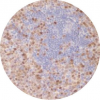Immunohistochemistry Catalog
CD79a
Clone: JCB117
Cat#: 10114
These antibodies recognize an extracellular epitope expressed on the CD79a molecule, and detects the full spectrum of B-cells. CD79a has been found to be co-expressed with CD3 in 10% of cases of T- lymphoblastic leukemia/ lymphoma . Useful in the differential diagnosis of Hodgkin's disease.
CD8
Clone: P17-V
Cat#: 10089
CD8 is a transmembrane glycoprotein co-receptor for the T cell receptor (TCR). CD8 binds to class I MHC protein. Immunohistoch emical staining of CD8 in tissue sections allow the quantitative detection of cytotoxic - suppressor T-lymphocytes.
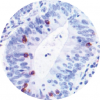
Fixed-embedded human colon cancer
CEA
Clone: COL1
Cat#: 10116
ln breast carcinomas, CEA (carcinoembryonic antigen, CD66e) staining correlated well with clinical outcome, independent of histologic type of tumors (with or without metastases) . Pancreatic carcinomas, testicular tumor, gall bladder neoplasms and granular cell myoblastomas sta in positive, whereas malignant tumors of brain, prostate, skin, lymphoreticular tissues, hepatocellular carcinomas, esophageal squamous cell carcinomas, and mesothelioma fai! to stain for CEA.
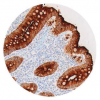
Fixed-embedded human colon
Chromogranin A
Clone: LK2H10
Cat#: 10117
Chromogranin A is present in a wide variety of endocrine tissues including the pituitary, pancreas, hypothalamus, thymus, thyroid, intestine, and parathyroid. Co-expression of chromogranin and NSE is typical of neuroendocrine neoplasms. Most pituitary adenomas and prolactinomas readily express chromogranin.
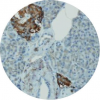
Fixed -embedded human pancreas
Colon cancer IHC kit
Cat#: 40011.K
COX-2
Clone: SP21
Cat#: 10075
COX-2 inhibition by nonsteroidal anti inflammatory agents has been shown to decrease angiogenesis and tumor grovvth, and promote apoptosis. COX-2 overexpression has been associated with increased microvascular density, and V EGF protein expression in head and neck squamous cell carcinoma and is an indicator of poor prognosis.

Fixed-embedded human colon cancer
Cyclin D1
Clone: SP4
Cat#: 10074
Immunodetection of Cyclin Dl is useful for separating mantle cell lymphomas (+) from SLL's and small cleaved cell lymphomas (-). Cyclin D , one of the key cell cycle regulators, is a putative proto-oncogene overexpressed in a wide variety of neoplasms. Cyclins govern transitions through distinct phases of the cell cycle by regulating the activity of the cyclin dependent kinases. ln mid to late Gl, Cyclin Dl shows maximum expression following growth factor stimulation.
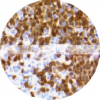
Fixed-embedded human mantle cell lymphoma
Cytokeratin (HMW)
Clone: 34βE12
Cat#: 10127
This antibody recognizes cytokeratins 1,5,10, and 14 that are found in complex epithelia. The 34βE12 labels myopeithelial cells and has been shown to be useful in distinguishing prostate adenocarcinoma from hyperplasia of the prostate. This antibody is also been useful in separating benign from malignant intraductal breast proliferations.

Fixed-embedded human prostate
Cytokeratin (HMW)
Clone: AE3
Cat#: 10126
This antibody recognizes most of the basic (Type II) keratins. It recognizes keratin polypeptides of 58 and 65 to 67 kDa. In keratinized epidermis, 58 kDa keratin is present in the basal and suprabasal layers,
while 65 to 67 kDa keratin are expressed by cells from upper layers. This antibody can be used to stain different cell layers in an epithelial tissue and various neoplasms of epithelial origin.
Cytokeratin (LMW)
Clone: AE1
Cat#: 10128
AE1 recognizes cytokeratins 10, 14, 15, 16, and 19 in the acidic subfamily.
Cytokeratin (pan)
Clone: KL1
Cat#: 10042
This monoclonal antibody reacts on normal and neoplastic cells of epithelial origin, it does not react on epidermal basal layer cells. Specificity: Cytokeratins 1, 2, 5, 6, 7, 8, 10, 11, 14, 16, 17, 18 and 19.
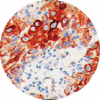
Fixed-embedded human lung cancer
Cytokeratin 14
Clone: D19-N
Cat#: DB 099
CK14 is a member of the type I keratin family of intermediate filament proteins, it has been reported to be expressed in neoplasms of squamous cell origin.
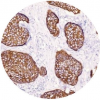
Fixed-embedded human squamous cell carcinoma
Cytokeratin 16
Clone: R20-S
Cat#: DB 100
CK16 is a type I cytokeratin. It is paired with CK6 in a number of epithelial tissues, including nail bed, oesophagus, tongue, and hair follicles. Mutations in the gene encoding this protein are associated with genetic skin disorders.
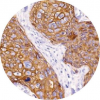
Fixed-embedded human skin squamous cell carcinoma
Cytokeratin 17
Clone: V21-R
Cat#: DB 101
In normal tissues, CKl7 is expressed by basal cells of complex epithelia, e.g. basal cells of pseudo-stratified epithelium in the trachea, larynx, bronchi, myoepithelial cells in salivary glands and sweat glands. In neoplastic tissue, CKl7 is expressed by squamous cell carcinomas of the lung, cervix and oral cavity.
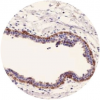
Fixed-embedded human breast


